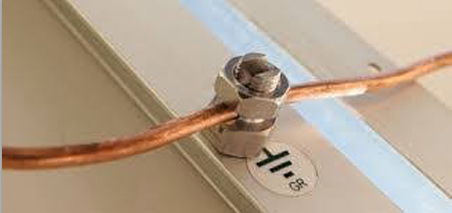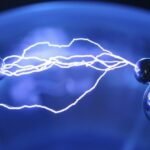The previous three sections of Lesson 2 discussed the three common methods of charging – charging by friction, charging by induction, and charging by conduction. A discussion of charging would not be complete without a discussion of uncharging. Objects with an excess of charge – either positive or negative – can have this charge removed by a process known as grounding. Grounding is the process of removingthe excess charge on an object by means of the transfer of electrons between it and another object of substantial size. When a charged object is grounded, the excess charge is balanced by the transfer of electrons between the charged object and a ground. A ground is simply an object that serves as a seemingly infinite reservoir of electrons; the ground is capable of transferring electrons to or receiving electrons from a charged object in order to neutralize that object. In this last section of Lesson 2, the process of grounding will be discussed.
Grounding a Negatively Charged Object
To begin our discussion of grounding, we will consider the grounding of a negatively charged electroscope. Any negatively charged object has an excess of electrons. If it is to have its charge removed, then it will have to lose its excess electrons. Once the excess electrons are removed from the object, there will be equal numbers of protons and electrons within the object and it will have a balance of charge. To remove the excess of electrons from a negatively charged electroscope, the electroscope will have to be connected by a conducting pathway to another object that is capable of receiving those electrons. The other object is the ground. In typical electrostatic experiments and demonstrations, this is simply done by touching the electroscope with one’s hand. Upon contact, the excess electrons leave the electroscope and enter the person who touches it. These excess electrons subsequently spread about the surface of the person.
removed, then it will have to lose its excess electrons. Once the excess electrons are removed from the object, there will be equal numbers of protons and electrons within the object and it will have a balance of charge. To remove the excess of electrons from a negatively charged electroscope, the electroscope will have to be connected by a conducting pathway to another object that is capable of receiving those electrons. The other object is the ground. In typical electrostatic experiments and demonstrations, this is simply done by touching the electroscope with one’s hand. Upon contact, the excess electrons leave the electroscope and enter the person who touches it. These excess electrons subsequently spread about the surface of the person.
This process of grounding works because excess electrons find each other repulsive. As is always the case, repulsive affects between like-charged electrons forces them to look for a means of spatially separating themselves from each other. This spatial separation is achieved by moving to a larger object that allows a greater surface area over which to spread. Because of the relative size of a person compared to a typical electroscope, the excess electrons (nearly all of them) are capable of reducing the repulsive forces by moving into the person (i.e., the ground). Like contact charging discussed earlier, grounding is simply another example of charge sharing between two objects. The extent to which an object is willing to share excess charge is proportional to its size. So an effective ground is simply an object with significant enough size to share the overwhelming majority of excess charge.
Grounding a Positively Charged Object
The previous discussion describes the grounding of a negatively charged electroscope. Electrons were transferred from the  electroscope to the ground. But what if the electroscope is positively charged? How does electron transfer allow an object with an excess of protons to become neutralized? To explore these questions, we will consider the grounding of a positively charged electroscope. A positively charged electroscope must gain electrons in order to acquire an equal number of protons and electrons. By gaining electrons from the ground, the electroscope will have a balance of charge and therefore be neutral. Thus, the grounding of a positively charged electroscope involves the transfer of electrons from the ground into the electroscope. This process works because excess positive charge on the electroscope attracts electrons from the ground (in this case, a person). While this may disrupt any balance of charge present on the person, the significantly larger size of the person allows for the excess charge to distance itself further from each other. As in the case of grounding a negatively charged electroscope, the grounding of a positively charged electroscope involves charge sharing. The excess positive charge is shared between the electroscope and the ground. And once again, the extent to which an object is willing to share excess charge is proportional to its size. The person is an effective ground because it has enough size to share the overwhelming majority of excess positive charge.
electroscope to the ground. But what if the electroscope is positively charged? How does electron transfer allow an object with an excess of protons to become neutralized? To explore these questions, we will consider the grounding of a positively charged electroscope. A positively charged electroscope must gain electrons in order to acquire an equal number of protons and electrons. By gaining electrons from the ground, the electroscope will have a balance of charge and therefore be neutral. Thus, the grounding of a positively charged electroscope involves the transfer of electrons from the ground into the electroscope. This process works because excess positive charge on the electroscope attracts electrons from the ground (in this case, a person). While this may disrupt any balance of charge present on the person, the significantly larger size of the person allows for the excess charge to distance itself further from each other. As in the case of grounding a negatively charged electroscope, the grounding of a positively charged electroscope involves charge sharing. The excess positive charge is shared between the electroscope and the ground. And once again, the extent to which an object is willing to share excess charge is proportional to its size. The person is an effective ground because it has enough size to share the overwhelming majority of excess positive charge.
The Need for a Conducting Pathway
Any object can be grounded provided that the charged atoms of that object have a conducting pathway between the atoms and the ground. A common lab activity involves taping two straws to a charged aluminum plate. One straw is covered with aluminum foil and the other straw is bare plastic. When the aluminum-covered straw is touched, the aluminum plate loses its charge. It is grounded by means of the movement of electrons from the ground to the aluminum plate. When the plastic straw is touched, grounding does not occur. The plastic serves as an insulator and prevents the flow of electrons from the ground to the aluminum plate. Grounding requires a conducting pathway between the ground and the object to be grounded. Electrons will travel along that pathway.

Lesson 2 of this unit of The Physics Classroom has been focused on methods of charging and discharging objects. One principle that continually arose was the relationship between force and distance.
Check Your Understanding
Use your understanding of charge to answer the following questions. When finished, click the button to view the answers.
1. A positively charged pop can is touched by a person standing on the ground. The pop can subsequently becomes neutral. The pop can becomes neutral during this process because ______.
a. electrons pass from the pop can to the person (ground)
b. electrons pass from the person (ground) to the pop can
c. protons pass from the pop can to the person (ground)
d. protons pass from the person (ground) to the pop can
See Answer

Answer: B
Protons do NOT move during electrostatic activities, so choices c and d can be ruled out. To ground a positively charged object, electrons must be added to it in order neutralize its excess positive charge. So electrons must move from the ground into the pop can.
2. A physics student, standing on the ground, touches an uncharged plastic baseball bat to a negatively charged electroscope. This will cause ___.
a. the electroscope to be grounded as electrons flow out of the electroscope.
b. the electroscope to be grounded as electrons flow into the electroscope.
c. the electroscope to be grounded as protons flow out of the electroscope.
d. the electroscope to be grounded as protons flow into the electroscope.
e. the baseball bat to acquire an excess of protons.
f. absolutely nothing (or very little) to happen since the plastic bat does not conduct.
See Answer

Answer: F
In order to ground an electroscope, electrons must have a conducting pathway between the ground and the object. In this case, a piece of plastic is part of the pathway connecting the ground (the student) and the charged object. Since plastic is an insulator, electrons are incapable of moving through the baseball bat. Grounding does not occur in this instance. Were there a conducting pathway available, choice a would be the proper choice.
3. TRUE or FALSE:
An object that becomes grounded gains neutrons during the grounding process.
See Answer

Answer: False
Neutrons are positioned in the nucleus of an atom. And like protons, neutrons are never transferred in electrostatic experiments. They are bound in the nucleus and cannot escape by ordinary electrostatic methods.


